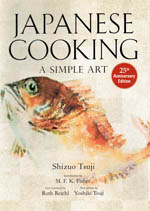Ingredients:
- 3 1/3 cups primary dashi, or secondary dashi, or sardine stock
- approximately 1/2 cup nameko mushrooms (or 2 shiitake mushrooms, sliced)
- 1/3 cake tofu
- 4 tbsp red miso
- 4 stalks trefoil
- ground sansho pepper
serves 4
In many ways, miso is to Japanese cooking what butter is to French cooking and olive oil to the Italian way (to paraphrase M.F.K. Fisher), and behind miso's omnipresence in the Japanese kitchen lies abundant common sense. Take miso-based soups. Not only do they require just a few minutes to prepare (an important criterion for a breakfast food), more important, typical servings provide roughly one-sixth the adult daily requirement of protein.
It is impossible for miso soup to be boring. It can be based on any type of miso, from salty to sweet, and it is always served with supplementary ingredients and seasonings. In the course of the four seasons, relying on easily available produce and nonseasonal staples, one can make a different miso soup nearly every day without repetition.
This is just one of the seemingly limitless variety of miso soups.
Directions
To prepare: Make the stock of your choice and assemble the supporting ingredients. Nameko mushrooms are available fresh and in cans; they are similar to conventional button mushrooms, but have a slippery coating. (Substitute shiitake mushrooms.) Drain the tofu.
To cook: Soften the miso in a medium-sized bowl by adding 2 tbsp tepid stock and blending with a wire whisk. If you put the miso directly into the stock pot, it will not be properly held in solution, and the soup will be full of miso pellets.
Gradually ladle the softened miso into the stock in a medium-sized pot, simmering over medium heat. (If you want satin-smooth soup, strain the soup from one pot into another.)
When all the miso has been added and is dissolved, add the solid ingredients. The tofu can be cut into 1/2-inch (1.5cm) cubes over the stock pot. Chop the trefoil stalks into small pieces. Keep soup at a simmer a few minutes until the mushrooms and tofu are heated.
Remove from heat just before boiling point. Do not boil - boiling will change the flavor.
To serve: Ladle into individual lacquer bowls, distributing the mushrooms, tofu, and chopped trefoil equally and attractively. Garnish with a shake or two of sansho pepper. Cover and serve immediately.

Reprinted with permission from the book:
Japanese Cooking: A Simple Art
Kodansha International
Easily the most comprehensive and exhaustive look at Japanese cuisine available, this groundbreaking classic marks its quarter-century anniversary in a revised edition with a new foreword by Gourmet editor-in-chief Ruth Reichl and a new preface by the late Tsuji's son, Yoshiki Tsuji.
Part cookbook, part philosophical treatise, this highly acclaimed collection offers a wealth of insight for amateurs and experts alike. Every technique associated with Japanese food is described step by step in great detail, along with illustrations to guide the reader through everything from filleting fish or cleaning an octopus to rolling omelets.
Sections on the Japanese meal, ingredients and selecting and cutting fish, chicken and vegetables offer great insight into the culture as well as the food. The recipe section of the book is divided by cooking method rather than food type, including grilled and pan-fried, steamed, simmered and deep-fried.
Dishes range from the simple, Pan-Broiled Salmon, to the more complex, Nagasaki-Style Braised Pork, and many dishes are vegetarian. Sushi and sashimi are covered in depth, as are knives, the proper way to slice the fish, and decorative presentations.
A complete guide to Japanese cooking, this collection is must-have for anyone interested in Japanese food or culture.
ISBN 978-4770030498
Y4800
- Order this book from amazon.com
- Order this book from amazon.co.jp (in Japan)
- Find this book at your local English-language bookstore in Japan
- Or use the ISBN to order from your local bookstore.







